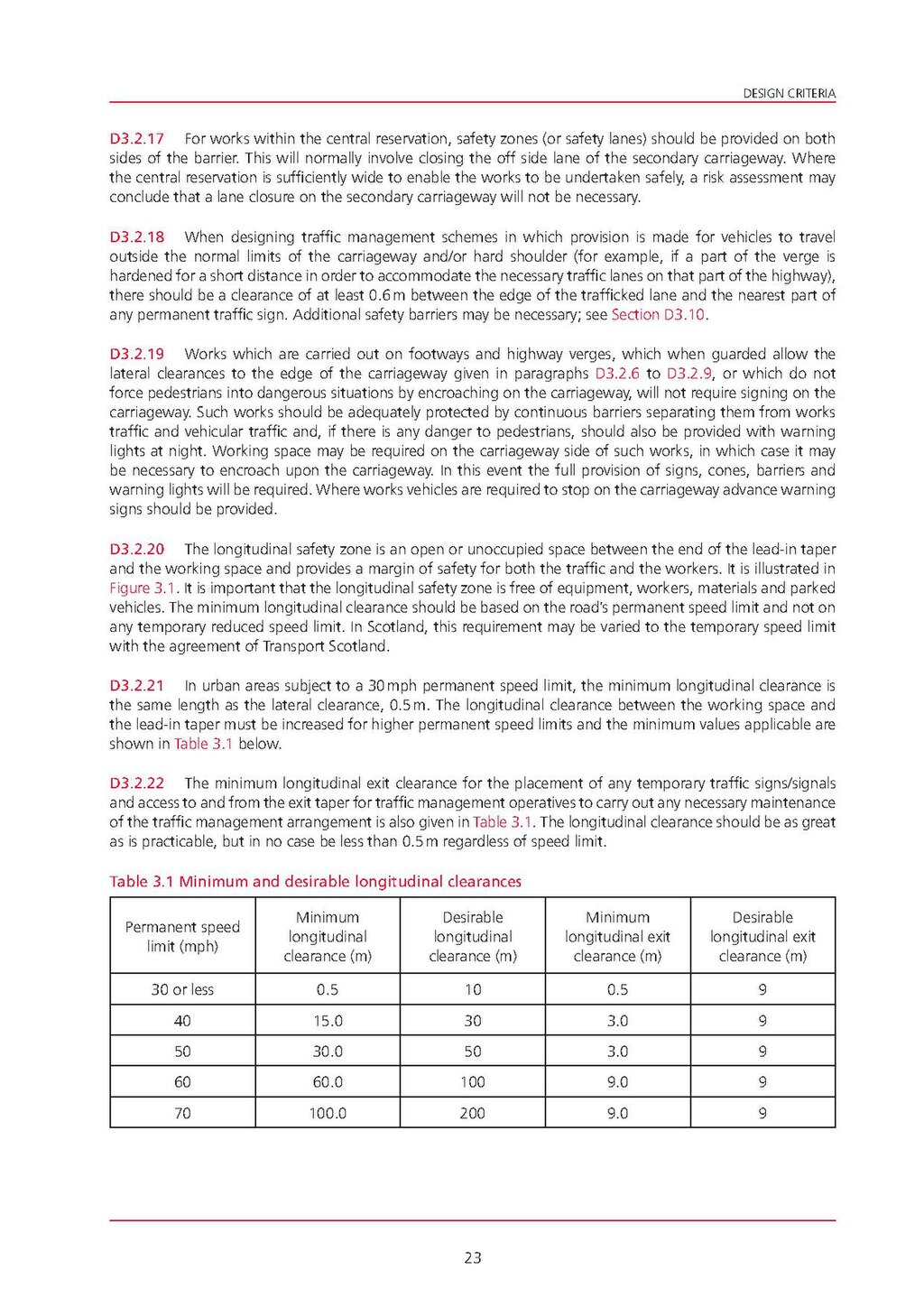D3.2.17 For works within the central reservation, safety zones (or safety lanes) should be provided on both sides of the barrier. This will normally involve closing the off side lane of the secondary carriageway. Where the central reservation is sufficiently wide to enable the works to be undertaken safely, a risk assessment may conclude that a lane closure on the secondary carriageway will not be necessary.
D3.2.18 When designing traffic management schemes in which provision is made for vehicles to travel outside the normal limits of the carriageway and/or hard shoulder (for example, if a part of the verge is hardened for a short distance in order to accommodate the necessary traffic lanes on that part of the highway), there should be a clearance of at least 0.6 m between the edge of the trafficked lane and the nearest part of any permanent traffic sign. Additional safety barriers may be necessary, see Section D3.10.
D3.2.19 Works which are carried out on footways and highway verges, which when guarded allow the lateral clearances to the edge of the carriageway given in paragraphs D3.2.6 to D3.2.9, or which do not force pedestrians into dangerous situations by encroaching on the carriageway, will not require signing on the carriageway. Such works should be adequately protected by continuous barriers separating them from works traffic and vehicular traffic and, if there is any danger to pedestrians, should also be provided with warning lights at night. Working space may be required on the carriageway side of such works, in which case it may be necessary to encroach upon the carriageway. In this event the full provision of signs, cones, barriers and warning lights will be required. Where works vehicles are required to stop on the carriageway advance warning signs should be provided.
D3.2.20 The longitudinal safety zone is an open or unoccupied space between the end of the lead-in taper and the working space and provides a margin of safety for both the traffic and the workers. It is illustrated in Figure 3.1. It is important that the longitudinal safety zone is free of equipment, workers, materials and parked vehicles. The minimum longitudinal clearance should be based on the roads permanent speed limit and not on any temporary reduced speed limit. In Scotland, this requirement may be varied to the temporary speed limit with the agreement of Transport Scotland.
D3.2.21 In urban areas subject to a 30 mph permanent speed limit, the minimum longitudinal clearance is the same length as the lateral clearance, 0.5 m. The longitudinal clearance between the working space and the lead-in taper must be increased for higher permanent speed limits and the minimum values applicable are shown in Table 3.1 below.
D3.2.22 The minimum longitudinal exit clearance for the placement of any temporary traffic signs/signals and access to and from the exit taper for traffic management operatives to carry out any necessary maintenance of the traffic management arrangement is also given in Table 3.1. The longitudinal clearance should be as great as is practicable, but in no case be less than 0.5 m regardless of speed limit.
| Permanent speed limit (mph) |
Minimum longitudinal clearance (m) |
Desirable longitudinal clearance (m) |
Minimum longitudinal exit clearance (m) |
Desirable longitudinal exit clearance (m) |
|---|---|---|---|---|
| 30 or less | 0.5 | 10 | 0.5 | 9 |
| 40 | 15.0 | 30 | 3.0 | 9 |
| 50 | 30.0 | 50 | 3.0 | 9 |
| 60 | 60.0 | 100 | 9.0 | 9 |
| 70 | 100.0 | 200 | 9.0 | 9 |
23
